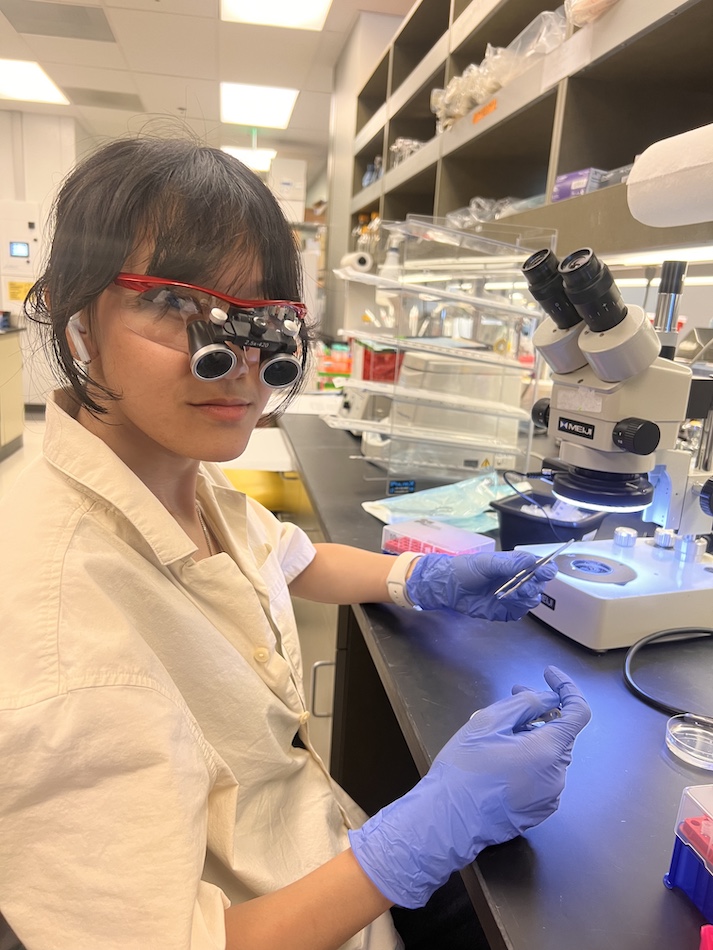On the second floor of the La Jolla Institute for Immunology (LJI), past rows of lab benches and freezers, is the bright, cozy room where Tom Riffelmacher, Ph.D., does his magic.
Using a machine called the Seahorse Metabolic Flux Analyzer, Riffelmacher captures immune cells in chambers just seven micrometers tall (roughly the width of a strand of spider silk). About 200,000 cells can fit in one of these chambers. These are living cells, and their new homes are lined with nutrients to keep them humming along.
Riffelmacher then closes up these little worlds, covering rows and rows of chambers with a high-tech membrane full of super-sensitive sensors. These sensors are mind boggling—and not just because each is barely larger than a speck of dust. Riffelmacher uses these advanced sensors to track (in real time!) metabolic activity in many different types of immune cells.
Riffelmacher is an instructor in the laboratory of LJI Professor Mitchell Kronenberg, Ph.D., and he directs the Institute’s newest research service, the Immunometabolism Core. As Core Director, Riffelmacher uses cutting-edge techniques to study how immune cells work—and how we might boost cellular metabolism to better fight disease.
“People come to me and ask, ‘I want to study the metabolism of my favorite immune cell, what should I do?’” says Riffelmacher.
Your body is, at the basic level, a giant chemical reaction. “Metabolism” refers to all the chemical processes keeping you alive. Individual cells have their own metabolism too, and scientists focus on two main metabolic “pathways” to understand cell survival.
The first pathway requires oxygen. “A cell is breathing just like you are breathing,” Riffelmacher explains. With the Seahorse, Riffelmacher can see activity in the oxygen consumption by measuring how much carbon dioxide the cells pump out into their little chambers. The second pathway relies on glucose, which cells break down as they produce energy. Riffelmacher can track activity in the glycolysis pathway to understand another side of cellular metabolism.
Scientists have known about cellular metabolism for a long time. Fish gotta swim, and cells gotta make energy, right? “Everyone was assuming these pathways were just active in the background,” says Riffelmacher. “People thought of these as ‘housekeeping’ pathways.”
Thanks to technological advances in the last five to 10 years, immunologists around the globe have shown that’s not the case. Metabolic pathways are in constant flux. Introduce a pathogen to an immune cell, and it doesn’t just keep breathing and breaking down glucose like normal. No, when an immune cell is under attack, it harnesses its metabolic pathways to wage war.
“These pathways affect how well an immune cell can respond to a pathogen,” says Riffelmacher.
LJI’s Immunometabolism Core allows scientists across the Institute to figure out how different immune cells are getting their energy. Are certain cells more reliant on oxygen or glucose when fighting influenza? Does the same hold true for cells fighting SARS-CoV-2?
Scientists need to answer these kinds of questions as they develop new drug therapies. Riffelmacher says future therapies could target metabolic pathways, “tuning” a cell’s fighting power against a specific threat, such as a virus or even a tumor cell.
LJI is one of the few places to provide this kind of metabolic analysis in house. Just steps away from the Seahorse is a special Biosafety Level 2 laboratory where Riffelmacher can infect immune cells with pathogens. He can then sort the cells into their little chambers to see how they’re doing.
The Seahorse also has injection ports that let Riffelmacher add chemicals to the little chambers. He can add a chemical to ramp up energy production in the cells, making their mitochondria “go crazy.” This kind of experiment is like a cellular stress test, and it can reveal a cell’s full respiratory capacity. Riffelmacher can also add a chemical that shuts down a cell’s metabolic pathways, which lets researchers determine what’s left in a cell after a particularly grueling battle.
The Core can also perform “metabolic flow” tests to reveal nutrient and metabolite consumption at a single-cell level. In a recent study, Riffelmacher and Kronenberg used metabolic flow to show how immune cells called MAIT cells use sugars and fats to fight viruses and bacteria.
The launch of the Immunometabolism Core continues to spark fascinating research projects. Riffelmacher has collaborated with LJI colleagues studying the fundamentals of T cell development, the roles of different immune cells in Crohn’s disease and heart disease, viral infections, obesity, and more.
“I love the collaborative part of the job,” says Riffelmacher. “So many projects have benefited from this technology at the Institute now—I’ve actually stopped counting.”
More from the Immunometabolism Core


